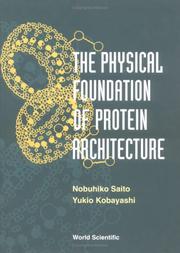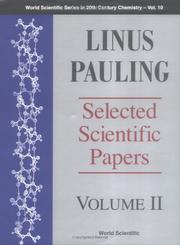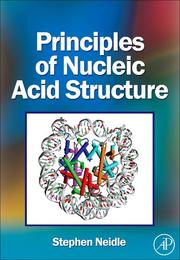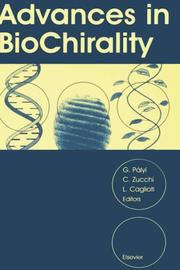| Listing 1 - 10 of 208 | << page >> |
Sort by
|

ISBN: 1281186759 9786611186753 0080528155 0444504419 9780444504418 9780080528151 6611186751 Year: 2000 Publisher: New York ; Amsterdam : Elsevier,
Abstract | Keywords | Export | Availability | Bookmark
 Loading...
Loading...Choose an application
- Reference Manager
- EndNote
- RefWorks (Direct export to RefWorks)
The bioseparation engineering of today includes downstream process engineering such as waste water, material and gas treatment. Taking this tendency into account, bioseparation engineers gathered in Japan as a special research group under the main theme of ""Recovery and Recycle of Resources to Protect the Global Environment"". The scope of this book is based on the conference, and deals not only with recent advances in bioseparation engineering in a narrow sence, but also the environmental engineering which includes waste water treatment and bioremediation. The contributors of this book
Biomolecules --- Molecular biology --- Separation --- Biological molecules --- Molecules
Book
ISBN: 1280375434 9786610375431 0585483442 9780585483443 Year: 1999 Publisher: Oxford : Oxford University Press,
Abstract | Keywords | Export | Availability | Bookmark
 Loading...
Loading...Choose an application
- Reference Manager
- EndNote
- RefWorks (Direct export to RefWorks)
Biomolecules and cells are critical components of biosensors and biomaterials, but in order to function in an artificial environment, they must be immobilized in a manner that does not affect their interaction with target analytes. Biosensors demonstrate that we can harness the incredible functions of living molecules and cells for our own purposes and are therefore at the forefront of technology. Moreover the applications of immobilized biomolecules and cells are expected to expand far beyond biosensor applications and indeed are already used for pharmaceutical production and testing. Biomaterials will become increasing common as they are being developed into toxic filters, artificial organs, and even silicon chips. This book provides a selection of methods for the immobilization of biomolecules and cells on a variety of surface with different geometries and chemistries so that they retain their function and guidelines on which method to use. Also included are the analytical techniques to measure the functionality of immobilized biomolecules. All the protocols have been tried and validated by the authors.; Immobilized Biomolecules in Analysis: A Practical Approach is an invaluable guide to all researchers in the fields of biosensors and biomaterials. Research in biosensors is carried out in a wide variety of fields including biochemistry, chemistry, engineering, laboratory medicine, environmental and defence research. The protocols are written so that an extensive prior knowledge of biochemistry is not required to use them.
Biomolecules. --- Biological molecules --- Molecules --- Molecular biology
Book
ISBN: 3036565787 3036565795 Year: 2023 Publisher: Basel : MDPI - Multidisciplinary Digital Publishing Institute,
Abstract | Keywords | Export | Availability | Bookmark
 Loading...
Loading...Choose an application
- Reference Manager
- EndNote
- RefWorks (Direct export to RefWorks)
This reprint compiles several studies on radiation interactions with biomolecules. The fragmentation induced by slow electron and electron scattering processes are described, and the induced processes by UV radiation are characterised. The present Special Issue offers complementary studies on radiation induced by photons and electrons in biological (and related) target molecules. The present collection provides important insights on radiation physics and chemistry and the advances in knowledge in these areas.
Biomolecules. --- Biological molecules --- Molecules --- Molecular biology

ISBN: 1281956570 9786611956578 981281101X 9789812811011 9781281956576 9789810247102 9810247109 Year: 2001 Publisher: Singapore ; River Edge, N.J. : World Scientific,
Abstract | Keywords | Export | Availability | Bookmark
 Loading...
Loading...Choose an application
- Reference Manager
- EndNote
- RefWorks (Direct export to RefWorks)
This work elucidates the mechanism of various processes in protein folding. The main features of protein folding are shown to be described by the island model with long range hydrophobic interaction which is capable of finding the specific residue, and the lampshade criterion for disulfide bonding.
Proteins --- Biomolecules --- Biological molecules --- Molecules --- Molecular biology --- Structure.

ISBN: 1281960861 9786611960865 9812811974 9789812811974 9789810229405 9810229402 9781281960863 Year: 2001 Publisher: River Edge, N.J. : World Scientific,
Abstract | Keywords | Export | Availability | Bookmark
 Loading...
Loading...Choose an application
- Reference Manager
- EndNote
- RefWorks (Direct export to RefWorks)
Linus Pauling wrote a stellar series of over 800 scientific papers spanning an amazing range of fields, some of which he himself initiated. This book is a selection of the most important of his writings in the fields of quantum mechanics, chemical bonding (covalent, ionic, metallic, and hydrogen bonding), molecular rotation and entropy, protein structure, hemoglobin, molecular disease, molecular evolution, the antibody mechanism, the molecular basis of anesthesia, orthomolecular medicine, radiation chemistry/biology, and nuclear structure. Through these papers the reader gets a fresh, unfilte
Chemistry. --- Biomolecules. --- Biological molecules --- Molecules --- Molecular biology --- Physical sciences
Book
ISBN: 9780323856386 0323856381 9780323857598 0323857590 Year: 2022 Publisher: London, England : Academic Press,
Abstract | Keywords | Export | Availability | Bookmark
 Loading...
Loading...Choose an application
- Reference Manager
- EndNote
- RefWorks (Direct export to RefWorks)
Biomolecules. --- Macromolecules. --- Molecules --- Supramolecular chemistry --- Molecular biology --- Biological molecules

ISBN: 9780123695079 0123695074 9780080553528 0080553524 1281059374 9781281059376 9786611059378 6611059377 Year: 2008 Publisher: Amsterdam : Boston : Elsevier ; Academic Press,
Abstract | Keywords | Export | Availability | Bookmark
 Loading...
Loading...Choose an application
- Reference Manager
- EndNote
- RefWorks (Direct export to RefWorks)
This unique and practical resource provides the most complete and concise summary of underlying principles and approaches to studying nucleic acid structure, including discussion of x-ray crystallography, NMR, molecular modelling, and databases. Its focus is on a survey of structures especially important for biomedical research and pharmacological applications. To aid novices, the book includes an introduction to technical lingo used to describe nucleic acid structure and conformations (roll, slide, twist, buckle, etc.). This completely updated edition features expanded coverage of the latest
Nucleic acids. --- Biomolecules. --- Biological molecules --- Molecules --- Molecular biology --- Polynucleotides --- Biomolecules

ISBN: 0080434045 9786611026882 1281026883 0080526624 9780080434049 9780080526621 9781281026880 Year: 1999 Publisher: New York : Elsevier,
Abstract | Keywords | Export | Availability | Bookmark
 Loading...
Loading...Choose an application
- Reference Manager
- EndNote
- RefWorks (Direct export to RefWorks)
Chirality is a fundamental, persistent, but often overlooked feature of all living organisms on the molecular level as well as on the macroscopic scale. The high degree of preference for only one of two possible mirror image forms in Nature, often called biological homochirality is a puzzling, and not yet fully understood, phenomenon. This book covers biological homochirality from an interdisciplinary approach - contributions range from synthetic chemists, theoretical topologists and physicists, from palaeontologists and biologists to space scientists and representatives of the pharm
Biomolecules --- Chirality --- Stereochemistry --- Symmetry (Physics) --- Enantiomers --- Biological molecules --- Molecules --- Molecular biology --- Biomolecules. --- Chirality.
Book
ISBN: 0128033703 012803369X 9780128033708 9780128033692 Year: 2018 Publisher: London : Elsevier,
Abstract | Keywords | Export | Availability | Bookmark
 Loading...
Loading...Choose an application
- Reference Manager
- EndNote
- RefWorks (Direct export to RefWorks)
Structural Biology in Immunology, Structure/Function of Novel Molecules of Immunologic Importance delivers important information on the structure and functional relationships in novel molecules of immunologic interest. Due to an increasingly sophisticated understanding of the immune system, the approach to the treatment of many immune-mediated diseases, including multiple sclerosis, systemic lupus erythematosus, rheumatoid arthritis, and inflammatory bowel disease has been dramatically altered. Furthermore, there is an increasing awareness of the critical role of the immune system in cancer biology. The improved central structure function relationships presented in this book will further enhance our ability to understand what defects in normal individuals can lead to disease.
Immunology. --- Biomolecules --- Structure. --- Biological molecules --- Molecules --- Molecular biology --- Immunobiology --- Life sciences --- Serology
Book
ISBN: 0471659193 Year: 1973 Publisher: New York Wiley
Abstract | Keywords | Export | Availability | Bookmark
 Loading...
Loading...Choose an application
- Reference Manager
- EndNote
- RefWorks (Direct export to RefWorks)
Biomolecules --- Molecular biology --- Molecular biochemistry --- Molecular biophysics --- Biochemistry --- Biophysics --- Systems biology --- Biological molecules --- Molecules --- Programmed instruction
| Listing 1 - 10 of 208 | << page >> |
Sort by
|

 Search
Search Feedback
Feedback About UniCat
About UniCat  Help
Help News
News